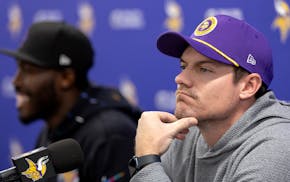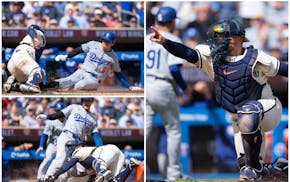When he played quarterback for the Vikings in the 1960s and '70s, Fran Tarkenton never paid attention to whether the footballs he threw were too heavy, too light or just right.
"Just grab the ball and throw it," Tarkenton said. "All of our footballs were hard."
Quarterbacks have come a long way in their obsession with a football's weight, shape, feel, smell and overall well-being. We can thank Tom Brady for shining a light on that emotional attachment.
Turns out, NFL quarterbacks are a meticulous bunch when it comes to footballs and getting them prepared for game day, even if they stop short of letting air out of them.
Once footballs arrive in shipment, equipment managers use — among various tricks — a dirt compound, water, players' sweat, Coca-Cola, special brushes, dryers, steam baths and good old-fashioned elbow grease to make footballs feel worn.
New footballs have a slick, waxy sheen that makes them hard to grip. Quarterbacks hate shiny footballs.
"You just can't play with a brand-new ball," former Vikings quarterback Randall Cunningham said. "It's virtually impossible. The statistics would never be what they are now."
In 15 seasons as an NFL quarterback, Gus Frerotte knew only one quarterback who preferred footballs right out of the box: Steve McNair.
"They were terrible footballs," Frerotte said. "But he loved them and he could throw them."
The NFL changed its rules in 2006 and allowed road teams to bring their own footballs after Brady and Peyton Manning organized a movement. Previously, the home team supplied footballs for both teams, which created variance for the visiting team.
The rule change allowed quarterbacks to use footballs worn to their liking, provided it's done legally. It's all about feel.
"You ever see a pitcher get a brand-new baseball and he throws it right back [to the umpire]?" Frerotte asked. "You're going, 'What could be wrong with that ball?' But they automatically know."
Most quarterbacks are incredibly particular about their preferences. ESPN analyst Tim Hasselbeck preferred less air, more nubby leather and raised laces.
"I was crazy picky," he said.
As a young player, Frerotte had equipment managers wrap new footballs in damp towels and put them in the dryer to soften the leather. Hasselbeck saw guys drench towels in Coke and wrap the footballs to add some tack. Hasselbeck liked to practice on grass in the morning to take advantage of dew.
Getting them ready
Quarterbacks say the best breaking-in method is to have teammates use footballs in practice to get sweat on them. Former Gophers/Denver Broncos quarterback Adam Weber only wanted running backs handling them.
And only the right amount of sweat.
"You can get too much sweat on it and ruin the ball," Weber said. "You have to find that perfect medium."
Hasselback knew a football needed more work if the ball discolored his hand.
"I would be like, 'Dude, my hand's pink. You didn't even get the first layer off,' " he said.
Former Viking Sage Rosenfels said geography plays a role in the process, too. When he played in Miami and Houston, his footballs would be game ready after only a few practices because of the high humidity.
That wasn't the case in Minnesota, but Rosenfels said Vikings longtime equipment manager Dennis Ryan had a special touch with footballs. Rosenfels declined to reveal Ryan's methods, saying only that everything was "all legal, the things that they did."
"It's a special sauce I don't think Dennis would give away," Rosenfels joked.
He's right. The Vikings wouldn't provide the secret formula, either.
Frerotte, who played for seven NFL teams, also gave his stamp of approval.
"Dennis is probably the best I've ever seen in getting the ball ready," he said. "The method that he uses is great because it doesn't ruin the integrity of the ball. It gets that wax off and gets you a good grip so you can throw it."
Picky, picky, picky
NFL game officials check each team's footballs to make sure they are properly inflated and not too worn. That's another important part of the process: Remove the slipperiness without making the footballs look too weathered for NFL's standards.
Rosenfels said starting quarterbacks pick out 12 to 15 footballs on Friday that go in a bag strictly used for games. In general, a football can be used two or three games before it gets tossed out.
Hasselbeck was primarily a backup in four NFL seasons but he "campaigned" for certain balls to be selected.
Said Hasselbeck: "I was like, 'Really, that's the one you picked? How could you like that one? If I have to go in and I'm playing with this ball, it's going to be terrible. Don't do that to me.' "
Not every quarterback is anal-retentive about a football's condition. Brett Favre probably could throw a brick 30 yards downfield between defenders.
"The guys that can really spin the ball usually are less particular," Rosenfels said.
In terms of inflation, Rosenfels preferred softer footballs, though he says he had no clue about PSI levels as a player.
"You can definitely tell when a ball is under-[inflated]," he said. "It's like, 'Oh, this ball is amazing.' Well, it's half-flat."
Weber went the other way. He preferred fully-inflated footballs because he has larger hands than most quarterbacks. If a ball felt under-inflated, he asked an equipment manager to put more air in it because his grip would create indentations and affect his release.
"You want a consistent ball that allows you to play your best," he said.
Ultimately, that's every quarterback's wish, whether the process requires sweat, soda or nothing at all.
Chip Scoggins • chip.scoggins@startribune.com

Scoggins: Worried about costly trade to draft a quarterback? Don't be.
Scoggins: 'Wait one more year' can't be the Wild's plan. Thankfully, it isn't.

Scoggins: Finch feeling heat of the Suns as playoff battle looms
Scoggins: Why 'championship or bust' fits these Wolves


